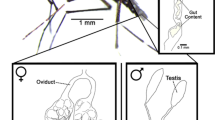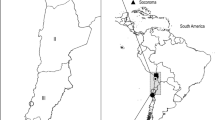Abstract
Bacteria of the genus Neorickettsia are obligate intracellular endosymbionts of parasitic flukes (Digenea) and are passed through the entire complex life cycle of the parasite by vertical transmission. Several species of Neorickettsia are known to cause diseases in domestic animals, wildlife, and humans. Quantitative data on the transmission of the bacteria through the digenean life cycle is almost completely lacking. This study quantified for the first time the abundance of Neorickettsia within multiple stages of the life cycle of the digenean Plagiorchis elegans. Snails Lymnaea stagnalis collected from a pond in North Dakota were screened for the presence of digenean cercariae, which were subsequently tested for the presence of Neorickettsia. Three L. stagnalis were found shedding P. elegans cercariae infected with Neorickettsia. These snails were used to initiate three separate laboratory life cycles and obtain all life cycle stages for bacterial quantification. A quantitative real-time PCR assay targeting the GroEL gene was developed to enumerate Neorickettsia sp. within different stages of the digenean life cycle. The number of bacteria significantly increased throughout all stages, from eggs to adults. The two largest increases in number of bacteria occurred during the period from eggs to cercariae and from 6-day metacercariae to 48-h juvenile worms. These two periods seem to be the most important for Neorickettsia propagation through the complex digenean life cycle and maturation in the definitive host.


Similar content being viewed by others
References
Cribb TH, Bray RA, Littlewood DTJ, Pichelin SP, Herniou EA (2001) The Digenea. In: Interrelationships of the Platyhelminthes. Taylor and Francis, London, pp 168–185
Dittrich S, Phuklia W, Turner GDH, Rattanavong S, Chansamouth V, Dumler SJ, Ferguson DJP, Paris DH, Newton PN (2015) Neorickettsia sennetsu as a neglected cause of fever in South-East Asia. PLoS Negl Trop Dis 9:e0003908. doi:10.1371/journal.pntd.0003908
Esch GW, Barger MA, Fellis KJ (2002) The transmission of digenetic trematodes: style elegance, complexity. Integr Comp Biol 42:304–312. doi:10.1093/icb/42.2.304
Goyal K, Qamra R, Mande SC (2006) Multiple gene duplication and rapid evolution in the groEL gene: functional implications. J Mol Evol 63:781–787. doi:10.1007/s00239-006-0037-7
Greiman SE, Tkach VV, Vaughan JA (2013) Transmission rates of the bacterial endosymbiont, Neorickettsia risticii, during the asexual phase of its digenean host, Plagiorchis elegans, within naturally infected lymnaeid snails. Parasit Vectors 6:303–309. doi:10.1186/1756-3305-6-303
Greiman SE, Tkach VV, Pulis E, Fayton TJ, Curran SS (2014) Large scale screening of Digeneans for Neorickettsia endosymbionts using real-time PCR reveals new Neorickettsia genotypes, host associations and geographic records. PLoS ONE 9:e98453. doi:10.1371/journal.pone.0098453
Greiman SE, Tkach M, Vaughan JA, Tkach VV (2015) Laboratory maintenance of the bacterial endosymbiont, Neorickettsia sp., through the life cycle of a digenean, Plagiorchis elegans. Exp Parasitol 157:78–83. doi:10.1016/j.exppara.2015.06.015
Greiman SE, Rikihisa Y, Cain J, Vaughan JA, Tkach VV (2016) Germs within worms: localization of Neorickettsia sp. within life cycle stages of the Digenean Plagiorchis elegans. Appl Environ Microbiol 82. doi:10.1128/AEM.04098-15
Mott J, Muramatsu Y, Seaton E, Martin C, Reed S, Rikihisa Y (2002) Molecular analysis of Ehrlichia risticii in adult aquatic insects in Pennsylvania, in horses infected by ingestion of insects, and isolated in cell culture. J Clin Microbiol 40:690–693. doi:10.1128/JCM.40.2.690-693.2002
Tkach VV, Pawlowski J (1999) A new method of DNA extraction from the ethanol-fixed parasitic worms. Acta Parasitol 44:147–148
Vaughan JA, Tkach VV, Greiman SE (2012) Neorickettsial endosymbionts of the Digenea: diversity, transmission and distribution. Adv Parasitol 79:253–297. doi:10.1016/B978-0-12-398457-9.00003-2
Acknowledgments
We are grateful to Dr. Jefferson Vaughan for providing larvae of Culex pipiens mosquitoes for the study and Elvira Tkach for assisting with the husbandry of hamsters. This work was funded by the grant R15AI092622 from the National Institute of Health, USA.
Author information
Authors and Affiliations
Corresponding author
Ethics declarations
The use of vertebrate animals (hamsters) was approved by the University of North Dakota IACUC (protocol 1011-1c).
Conflict of interest
The authors have no conflict of interests.
Rights and permissions
About this article
Cite this article
Greiman, S.E., Tkach, V.V. The numbers game: quantitative analysis of Neorickettsia sp. propagation through complex life cycle of its digenean host using realtime qPCR. Parasitol Res 115, 2779–2788 (2016). https://doi.org/10.1007/s00436-016-5027-0
Received:
Accepted:
Published:
Issue Date:
DOI: https://doi.org/10.1007/s00436-016-5027-0




